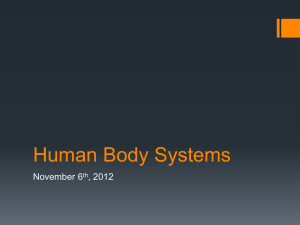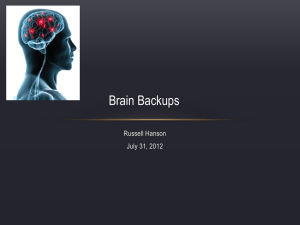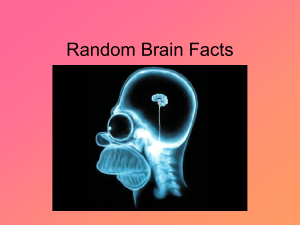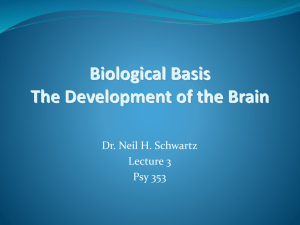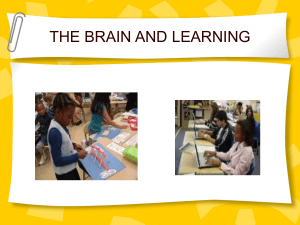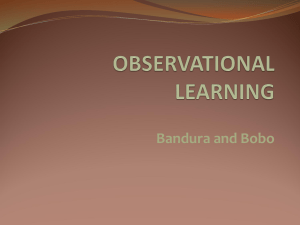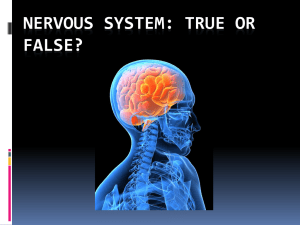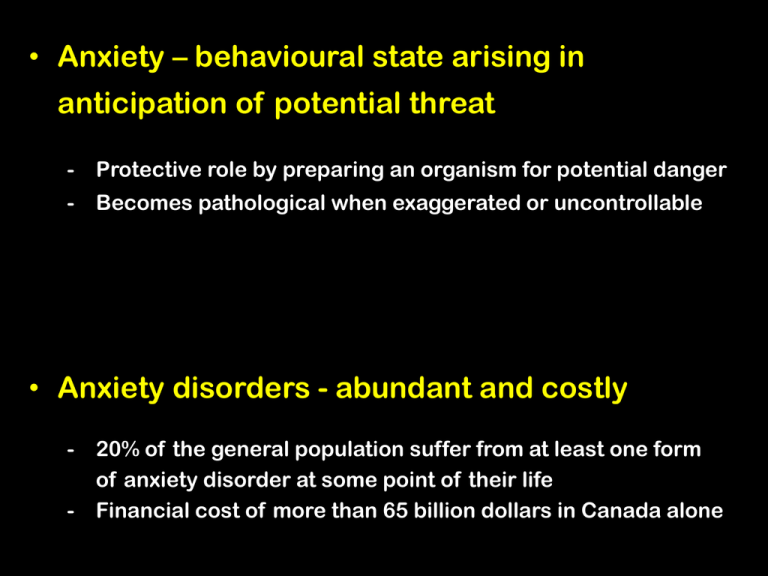
• Anxiety – behavioural state arising in
anticipation of potential threat
-
Protective role by preparing an organism for potential danger
-
Becomes pathological when exaggerated or uncontrollable
• Anxiety disorders - abundant and costly
-
20% of the general population suffer from at least one form
of anxiety disorder at some point of their life
Financial cost of more than 65 billion dollars in Canada alone
Neural substrates underlying anxiety
1. A neural substrate defined by gene
expression pattern in the developing embryo
2. A neural substrate defined by connectivity
in the adult brain
Neural substrates underlying anxiety
1. A neural substrate defined by gene
expression pattern in the developing embryo
- Genetically distinct subset of serotonergic neurons
2. A neural substrate defined by connectivity
in the adult brain
- Hippocampus to amygdala connection
Serotonin (5HT)-producing
neurons
9 clusters
(nuclei) B1-B9
BRAINSTEM
• Autonomic body physiology
modulation of breathing,
body temperature
blood pressure
heart rate
• learning and memory
• sensorimotor gating
• modulation of mood states
Serotonin (5HT)-producing
neurons
9 clusters
(nuclei) B1-B9
BRAINSTEM
• Autonomic body physiology
modulation of breathing,
body temperature
blood pressure
heart rate
• learning and memory
• sensorimotor gating
• modulation of mood states
Serotonergic neurons are implicated
in a range of clinical disorders:
•
•
Sudden infant death
syndrome
Fetal alcohol syndrome
Autism
•
•
•
Anxiety
Depression
Addiction and Compulsive behaviors
•
Serotonin (5HT)-producing
neurons
9 clusters
(nuclei) B1-B9
BRAINSTEM
Serotonergic neurons have different functional properties
•
different Anatomical locations
•
different Projection patterns
•
different Cell morphologies
•
different Physiological properties
Message: there are many subtypes of
serotonergic neurons
Which serotonin neurons underlie
which behaviors and physiological processes?
?
•
•
•
•
•
•
•
breathing
heart rate
blood pressure
learning and memory
sensorimotor gating
anxiety
aggression
Defining serotonergic neurons
by gene expression pattern during early development
?
•
•
•
•
•
•
•
breathing
heart rate
blood pressure
learning and memory
sensorimotor gating
anxiety
aggression
Serotonergic neuron progenitors are located in embryonic
hindbrain
embryonic
hindbrain
Serotonergic
progenitors
Serotonergic progenitors
r1
r4
r7
dorsal view
Embryonic hindbrain is composed of morphologically
distinct structures called rhombomeres
embryonic
hindbrain
Serotonergic progenitors
r1
r2
r3
r4
r5
r6
r7
dorsal view
Rhombomeres are molecularly distinct structures
expressing different sets of genes
rhombomeres
embryonic
hindbrain
Serotonergic progenitors
r1
r2
r3
r4
r5
r6
r7
Hoxa-2
Hoxb-2
Hoxa-4
Adapted from Lumsden and Krumlauf, 1996
embryonic
hindbrain
Serotonergic progenitors
Rhombomeres are molecularly distinct structures
expressing different sets of genes
dorsal view
Message:
serotonergic neuron
progenitors in different
rhombomeres have different
gene expression pattern
Serotonergic progenitors
embryonic
hindbrain
Question:
How the embryonic gene
expression patterns are related to
serotonergic neuron function?
dorsal view
Dual recombinase-mediated gene activation
loxP
BAP
loxP
FRT
FRT
effector
OFF
Dual recombinase-mediated gene activation
loxP
loxP
FRT
FRT
effector
BAP
excision
Cre
FRT
BAP
FRT
effector
OFF
OFF
Dual recombinase-mediated gene activation
loxP
loxP
FRT
FRT
effector
BAP
Flp
loxP
BAP
OFF
excision
loxP
effector
OFF
Dual recombinase-mediated gene activation
loxP
loxP
FRT
FRT
effector
BAP
Cre
BAP
Flp
effector
ON
OFF
Dual recombinase-mediated gene activation
loxP
loxP
FRT
FRT
effector
BAP
GeneB::Flp
GeneA::Cre
effector
BAP
cre
Flp
ON
OFF
Dual recombinase-mediated gene activation
loxP
loxP
FRT
FRT
effector
BAP
GeneA::Cre
BAP
GeneB::Flp
effector
Effector
ON
ON
OFF
rosa26
FRT
CAG promoter
F
FRT loxP
F
Flpe
rosa26
CAG promoter
loxP
P
P
GFP
P
GFP
GFP-TOX
Cre
F
r1
r2
r3
r4
r5
Rhombomere-specific Cre lines
r6
r7
Pet1-Flpe
Serotonergic-specific Flpe
ON
OFF
ON
rosa26
FRT
CAG promoter
F
FRT loxP
F
Flpe
rosa26
r1
r2
r3
r4
Rhombomerespecific Cre lines
r5
r6
r7
Pet1-Flpe
Serotonergic-specific Flpe
ON
CAG promoter
loxP
P
P
GFP
P
GFP
GFP-TOX
OFF
Cre
F
ON
Genetic fate map of serotonergic neurons
Jensen et al, Nature Neuroscience 2008
Genetic fate map of serotonergic neurons
contributions
from a single
rhombomere
Jensen et al, Nature Neuroscience 2008
Genetic fate map of serotonergic neurons
contributions
from a single
rhombomere
contributions
from multiple
rhombomeres
contributions
from multiple
rhombomeres
Jensen et al, Nature Neuroscience 2008
Message #1:
Genetic Fate map = Classical, Anatomical Map
contributions
from a single
rhombomere
contributions
from multiple
rhombomeres
contributions
from multiple
rhombomeres
Message #1:
Genetic Fate map = Classical, Anatomical Map
contributions
from a single
rhombomere
contributions
from multiple
rhombomeres
contributions
from multiple
rhombomeres
Message #2:
provide framework to study the function of genetically
defined serotonergic neuron subtypes
Question:
How the embryonic gene expression patterns are
related to serotonergic neuron function?
GOAL - Silence individual serotonergic neuron subtypes to
determine their function
loxP
BAP
loxP
FRT
FRT
GFP-TOX
GOAL - Silence individual serotonergic neuron subtypes to
determine their function
loxP
BAP
loxP
FRT
FRT
GFP-TOX
Tetanus toxin light chain :
blocks neurotransmitter release
FIRST - silence all serotonergic neurons to reveal the full
extent of attainable phenotypes
loxP
BAP
loxP
FRT
FRT
GFP-TOX
Assayed a set of 3 behaviors known to be modulated by
serotonin (5-HT):
contextual
learning
• contextual fear
conditioning
anxiety-related
behaviors
• open field
sensorimotor gating
• prepulse inhibition of
acoustic startle
• elevated zero
maze
• light-dark
exploration test
Collaborator
Melloni Cook
Tennessee Mouse Genome Consortium
Neuromutagenesis Project
Contextual Fear Conditioning Paradigm
24hrs
assay fear-induced freezing
repeat x3 at 2.5 min intervals
Can they learn to associate an aversive stimulus to a particular cage
context?
Contextual Fear Conditioning Paradigm
24hrs
assay fear-induced freezing
repeat x3 at 2.5 min intervals
enhanced
fear induced
freezing
behavior
p<.044
“silenced” mice show enhanced contextual learning and
memory
24hrs
assay fear-induced freezing
Activity in the altered context
repeat x3 at 2.5 min intervals
No difference
No difference
enhanced
fear induced
freezing
behavior
p<.044
Control
triple
innate fear
of open areas
vs.
desire to explore
novel environments
Mice with higher level of
anxiety-related behavior
spend more time here.
Elevated zero maze
(advancement over Plus maze)
Light-dark
exploration test
Open field test
3 tests of anxiety-related behaviors
Elevated zero maze
Open field test
Light-dark exploration
test
*
*p< 0.03
n=34
n=32
A 2-factor (genotype x sex) multivariate analysis of variance
(MANOVA) was used. F(1,62)=4.81, p<.032
“silenced” mice
(ePet1::Flpe, hßact::Cre, RC::PFtox)
contextual
learning
anxiety-related
behaviors
sensorimotor gating
sensorimotor gating:
a neurological gating process that prevents
distracting sensory inputs from generating
unnecessary motor outputs
Stimulus intensity
regulation is disrupted in Schizophrenia
and Huntington disease
pulse
120 dB
Startle
response
TIME
% inhibition
Stimulus intensity
operationally measured by inhibition of
the acoustic startle response after a
leading (prepulse) stimulus
: indication of
sensorimotor gating
85 dB
prepulse
TIME
“Silenced” mice exhibited less of a startle in presence of a prepulse
“Silenced” mice show enhanced sensorimotor gating.
Prepulse Inhibition (PPI) test
P<.007
Mean percentage
Inhibition of
Startle Response
P<.023
background
white noise
control
“silenced” - Pet1Flpe, hßact-cre, RC::PFtox
“silenced” all serotonergic neurons
contextual
learning
anxiety-related
behaviors
sensorimotor gating
“silenced” all serotonergic neurons
contextual
learning
anxiety-related
behaviors
sensorimotor gating
Do serotonergic neurons with different embryonic origins
serve different functions?
What if we “silence” just the r1-derived 5-HT neurons?
contextual
learning
TOX in
All
5-HT neurons
r1-derived
5-HT neurons
?
anxiety-related
behaviors
?
sensorimotor gating
?
contextual
learning
anxiety-related
behaviors
silence
all
5-HT neurons
r1-derived
p<.03
sensorimotor gating
contextual
learning
anxiety-related
behaviors
sensorimotor gating
silence
all
5-HT neurons
r1-derived
no difference
no difference
p<.03
R1-derived 5-HT neurons may modulate anxiety-related behaviors
contextual
learning
anxiety-related
behaviors
sensorimotor gating
silence
all
5-HT neurons
r1-derived
no difference
no difference
Anxietyrelated
behaviors
Modulated more by r2- and/or r3-derived 5-HT neurons?
contextual
learning
anxiety-related
behaviors
sensorimotor gating
silence
all
5-HT neurons
r1-derived
no difference
no difference
Anxietyrelated
behaviors
Contextual learning
Sensorimotor gating
Modulated more by r2- and/or r3-derived 5-HT neurons?
contextual
learning
anxiety-related
behaviors
sensorimotor gating
silence
all
5-HT neurons
r1-derived
r2-derived
r3-derived
r5-derived
no difference
no difference
GOAL - Assigning specific serotonergic neuron subtypes to specific
behaviors
contextual
learning
serotonergic neuron
subtype
?
anxiety-related
behaviors
X
sensorimotor gating
?
Neural substrates underlying anxiety
1. A neural substrate defined by gene
expression pattern in the developing embryo
- Genetically distinct subset of serotonergic neurons
2. A neural substrate defined by connectivity
in the adult brain
- Hippocampus to amygdala connection
Amygdala and Anxiety
• c-Fos induction upon exposure to
anxiogenic stimuli (Hale et al., 2006;
Knapska et al., 2007)
• Stimulating the BLA increases
anxiety : GABA antagonist bicucullin
infusion into the BLA (Sajdyk et al., 1999,
2002; Spiga et al., 2006)
• Suppressing the BLA decrease
anxiety : glutamate blocker infusion into
the BLA (Sajdyk et al., 1997)
Hippocampus and Anxiety
• Sustained anxiety activates the vHPC :
Brain imaging with human and rhesus monkeys (Oler et al., 2010; Hasler et al., 2007)
• Stimulating the vHPC increases anxiety :
GABA antagonist Bicuculline or picrotoxin infusion (Rezvanfard et al. 2009; Bast T et al., 2001)
• Suppressing the vHPC reduces anxiety :
GABA agonist infusion or mechanical lesion (Kjelstrup et al., 2002; Bannerman et al., 2003; Mchugh et al., 2004;
Trent et al., 2010; Mceown et al. 2010)
Amygdala and HPC are reciprocally connected
Basolateral Amygdala
Ventral hippocampus
Amygdala and HPC likely coordinate with each
other to control anxiety behaviours
Q. How does the neural communication between the two
structures contributes to anxiety?
Optogenetic
manipulation
AAV-hSyn-ChR2-YFP
473nm blue laser
Behavioural consequence of
activating the vHPC to BLA inputs
Which subregions of the vHPC project to
the BLA?
Cholera toxin B chain (CTB)
Ventral CA1, subiculum, lateral
entorhinal cortex project to the
basolateral amygdala
dorsal
intermediate
ventral
AAV-hSyn-ChR2-YFP
BLA
mPFC
Hypothalamus
200um optic
fiber delivering
473nm laser
AAV-hSyn-ChR2-YFP
BLA
mPFC
Hypothalamus
Optogenetic stimulation of vHPC axon terminals
at the basolateral amygdala
N= 12
Mice were tested in 4 consecutive sessions
of 5 min EPM (OFF/ON/OFF/ON)
% OPEN TIME
25
20
15
10
5
0
OFF 1
ON 1
OFF 2
ON 2
Acute stimulation of vHPC terminals at the BLA induced anxiety
behaviors in the EPM
% OPEN TIME
25
20
15
10
5
0
OFF 1
ON 1
OFF 2
ON 2
Acute stimulation of vHPC terminals at the BLA induced anxiety
behaviors in the EPM
Optogenetic stimulation of vHPC axon terminals
at the basolateral amygdala
DISTANCE TRAVELED (m)
% OPEN TIME
25
10
20
8
15
6
10
4
5
2
0
0
OFF 1 ON 1 OFF 2 ON 2
OFF 1
ON 1
OFF 2
ON 2
Summary
Genetic approaches to link neurons to behaviors
A neural substrate defined by gene expression
pattern in the developing embryo
- Genetically distinct subtype of 5-HT neurons derived by
rhombomere 1
A neural substrate defined by connectivity in
the adult brain
- vHPC to BLA connection
- Acute stimulation of the vHPC to BLA inputs is sufficient to
induce anxiety behaviours in mice
Part 1.
Harvard University
•Susan Dymecki
•Wade Reghre
•Patricia Jensen
•Jia Jia Mai
Natural Sciences and
Engineering Research
Council of Canada
University of Memphis
•Melloni Cook
Canadian Foundation
Fighting Blindness
Part 2.
University of Toronto
•Shadi Bakir
•Robin Nguyen
•Wendy Xin
National Institute of
Heath
Site specific DNA excision by recombinase
loxP
loxP
DNA target
excision
Cre
Site specific DNA excision by recombinase
FRT
FRT
DNA target
excision
Flp
Recombinase-mediated gene activation
loxP
loxP
BAP
: Broadly
Active
Promoter
effector
Transcriptional
STOP
sequences
OFF
Recombinase-mediated gene activation
loxP
loxP
BAP
effector
excision
Cre
BAP
effector
ON
OFF
• Activity modulator (silence/activate neuron activity)
• Ablator (kill neurons)
• Fluorescent reporter (label neurons)
embryonic
hindbrain
Serotonergic progenitors
Where do serotonergic neurons originating from different
rhombomeres settle in the adult brain?
dorsal view
?
Hippocampus and Anxiety
Spatial learning
Anxiety
•
Sustained anxiety activates the vHPC :
Brain imaging with human and rhesus monkeys (Oler et al., 2010; Hasler et al., 2007)
•
Stimulating the vHPC increases anxiety :
GABA antagonist Bicuculline or picrotoxin infusion (Rezvanfard et al. 2009; Bast T et al., 2001)
•
Suppressing the vHPC reduces anxiety :
GABA agonist infusion or mechanical lesion (Kjelstrup et al., 2002; Bannerman et al., 2003; Mchugh et al., 2004; Trent et al., 2010;
Mceown et al. 2010)


